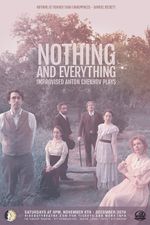Nothing and Everything
| Nothing and Everything | |
|---|---|
| Theater | The Hideout Theatre |
| Directed by | Jon Bolden |
| Assistant Director(s) | |
| Cast | |
| Crew | |
| Initial Run | Nov/Dec 2014 |
| Subsequent Run(s) | Aug 2015 |
Nothing and Everything was a narrative improv show inspired by the works of Anton Chekhov. It was a mainstage show at The Hideout Theatre.
Show Style
The show took place on a rural Russian estate in the 1890s. The costumes, while not absolutely period-perfect, suggested that era while conveying an out-of-time quality. Similarly, the stage was filled with props and furniture that suggest the time period and location -- in fact, the show featured no spacework whatsoever, using only real, physical props and furniture.
The show was an ensemble piece, and focused on no particular hero. Each performance included as much of the total cast as available -- in practical terms, this means that between eight and eleven performers were in each show. Each performer played one character, and the characters had a complex mesh of relationships, with families, neighbors, friends, and servants all interacting.
The acting style was fairly naturalistic, with the stage improvisors often playing characters close to themselves rather than extremely heightened types, and much of the show occurring in the un-heightened circumstances of those characters' everyday lives. Extreme emotions tended to be tamped down until outbursts later in the play. The performers explored the characters, either with lengthy monologs of their own, or through descriptions of offstage characters. Characters didn't particularly change from the start of the play to the end.
The show featured long scenes that shifted focus and composition over time. Characters entered, characters exited, and the scene concerned itself with one conversation, then another, perhaps expanding to a large group scene before homing in again on smaller clusters of people. Frequently one cluster within a scene was completely unaware of another, leading to independent conversations within the same scene. The show rarely if ever "went for the joke", aiming instead for the rhythms of natural conversation, drawing on character-based humor rather than well-constructed punch lines.
The tech aimed to avoid being 'busy'. The lights featured slow isolations focussing the audience on particular characters or conversations, but tended to keep the same feel for each act (see below). Likewise, sound tended to be very sparing with sound effects -- as with Chekhov, the production aimed to make every sound effect something that's significant to the story.
The show wrestled with the same themes as Chekhov's "big four" (The Seagull, Three Sisters, Uncle Vanya, The Cherry Orchard). Characters were often frustrated with the ineffectuality of their own lives or of the nation as a whole. Passionate, romantic feelings went unrequited. The characters lived in a historical context where the aristocracy was fading in power and relevance, and nobody was certain what would replace it.
At the same time, the show aimed more for realism than for traditional "everyone learns a lesson" storytelling. It aimed for minor-key depictions of real life, caring as much about giving the audience a brief window into this world as it does about any traditional notions of plot.
Show Structure
The director introduced the show, and got several suggestions from the audience: the number of actors in the first scene, what time of year the story begins in, and a prop (selected from four on a tray) to give to one of the initial characters. Then there was a four-act improvised play, with an intermission between acts two and three. Each act was a monoscene, and the acts occured in chronological order.
The first act served to introduce all the characters, with everyone in the cast having at least a brief speaking role. It showed the characters in normal, everyday mode -- everyone was more-or-less happy with each other, and there were no strenuous conflicts beyond the sort of tiffs that happen every day. This section of the show featured the most exposition, establishing all the characters, all of their relationships, and any simmering resentments or frustrations they have.
The second act took place after a short time jump (often a day or two), and further developed the world.
The third act, after intermission, took place after a longer time jump (usually some number of months), and was where the conflicts developed in the first half came to a head and a resolution.
Finally, act four, which took place after a short time jump, depicted the fallout from act three, and the new status quo that had settled in.
History
The show featured an unadvertised preview performance two days before its premiere.
It was part of The 2015 Improvised Play Festival.
Media
Videos
- 2014 Hideout Theatre Run:
- Video by Peter Rogers of the 11/6/14 preview (incomplete).
- Video by Peter Rogers of the 11/8/14 show.
- Video by Peter Rogers of the 11/15/14 show.
- Video by Peter Rogers of the 11/29/14 show.
- Video by Peter Rogers of the 12/13/14 show.
- Video by Peter Rogers of the 12/20/14 show. (The infamous flower catch is at time code 1:03. Hideout direct post is here: https://www.facebook.com/groups/hideouttheatre/permalink/853007534722352/)
- 2015 Long Center run:
Photos
- 2014 Hideout Theatre Run:
- Photoset by Steve Rogers of the 11/6/14 preview.
- Photoset by Chad Wellington of the 11/22/14 show.
- Photoset by Michael Yew of the 12/20/14 show.
- 2015 Long Center run:
- Photos by Michael Yew from the run.
- Photoset by Steve Rogers of the 8/20/15 show.
- Photoset by Steve Rogers of the 8/23/15 show.
More Information
- Show announcement in the Hideout's 2014 season preview.
- The show's web page.
- Thoughts on the show from Andrew Buck: 1, 2, 3.
- A faux interview with Chekhov by Andrew Buck.
- Admiring quotes about the show from the Hideout's blog.
